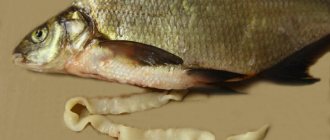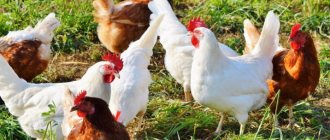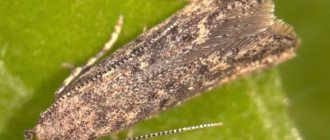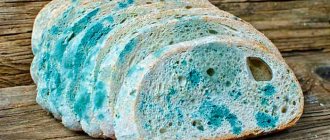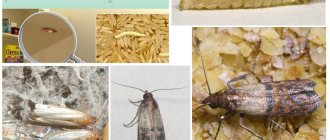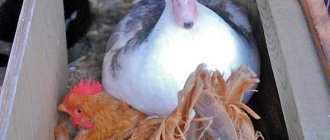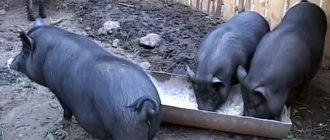Sea fish is not as rich in parasites as river fish, but it cannot be considered completely safe. In terms of the number of helminths encountered, pollock looks more modest than other breeds, because its habitat is cool waters at great depths. However, parasites also live in pollock, and some of them are dangerous to humans. The problem has become increasingly urgent in recent years due to the fact that this inexpensive fish has begun to appear more and more often on people's tables. What worms are pollock lovers at risk of becoming infected with, and how you can avoid the disease - read more about this.
Types and their description
There are many types of parasites that can live in the body of pollock. Among them there are nematodes, cestodes, trematodes, annelids, and microsporidia. The following are most often found in the catch:
Nibelinia
These are small parasites, rarely growing above 2–5 mm, found in fish caught in the Pacific and Atlantic Oceans, and the Sea of Okhotsk. It enters the body of pollock through crustaceans, which are food for fish. Parasitizes the body cavity, liver and other organs. The largest number of Nibelinia are found in older fish. Unlike other cod representatives, the parasite in pollock does not die after being caught.
Parasites
A clear sign of fish infection is the appearance of the fillet. It becomes loose due to many transverse breaks.
Aprocotyle pollock
The larva of this worm enters pollock through the skin, where it grows into an adult. The parasite colonizes the vessels of the gills, heart muscle, and lymphatic system, which leads to the development of anemia in fish. At the same time, she becomes thin, and her gills acquire a gray tint.
Spirurid nematodes
Infection with roundworms occurs when fish ingest intermediate hosts. In pollock, worms parasitize mainly in the intestines. Occasionally, larvae are found in other internal organs.
Anisakids
Anisakids are rightfully considered the most common parasites in pollock. There are both varieties that are harmless to humans and those that pose a serious threat.
Worm larvae come in white, colorless and red colors. In pollock, they settle in the intestines and other internal organs, and are also found in muscle tissue. Externally, helminths look like twisted spirals that are visible to the naked eye. If contaminated, the product should not be eaten or given as food to pets.
cod worm
The cod or seal worm belongs to the anisakid family. Fish is an intermediate host for them. The main species are pinnipeds and cetaceans. Helminths enter pollock when it eats infected crustaceans. In the body of a fish, the worm grows up to 6 cm, affecting the intestines, stomach walls, and muscles. The parasite is common in oceans around the world. Dies at high temperatures.
Pyramicocephals
Pyramicocephalic helminths are found in the liver, intestines, muscles, and between the pyloric appendages. They are quite large with a long tail reaching 5 cm. Adults grow up to several meters. The parasite is found in all Far Eastern seas. Especially common in pollock caught in the Sea of Okhotsk. Diphyllobothrium belongs to the class of tapeworms.
The contaminated product is not recommended for consumption even after heat treatment.
Prevention of infection
Larvae or worms found in fish immediately suggest that contaminated fish products may have been previously consumed.
In order to protect your loved ones and yourself from unpleasant consequences, it is recommended to follow simple measures:
- It is not recommended to consume dishes with raw fish - these are rolls and sushi;
- It is not recommended to consume lightly marinated products, as well as cold smoked sea fish;
- it takes at least half an hour to cook and fry a raw or freshly frozen product;
- observe the rules of personal hygiene;
- If parasites are found in fish, it is recommended to stop eating it.
If you suspect that you have eaten contaminated fish, you should take an antiparasitic medication within a few hours afterward. Despite the fact that sea fish can be dangerous, it is certainly necessary to eat it, because it is very important for the human body. In order to protect yourself and your family, it is recommended to follow basic safety rules regarding the preparation of the product and its consumption.
Fish, and especially sea fish, has long become an integral part of the diet of the majority of humanity around the globe. And all because it contains many beneficial properties, microelements and vitamins. But in addition to the colossal advantages, the slave has disadvantages, which are expressed in the parasites present in it.
Today you can buy any fish in almost any supermarket, without any restrictions, but the main thing is not to forget that any fish is highly susceptible to a huge number of parasites, which, when eaten by humans, can cause the most dangerous diseases.
Many people mistakenly believe that sea fish are practically not infected with parasites, and if they are infected, it is extremely rare.
It is worth mentioning that in 2007, an extensive study was carried out on the content of parasites in fish, and upon inspection it was revealed that of the control number of examined individuals, helminths affected over 40%.
What helminths can parasitize pollock?
Pollock infected with helminths is common. In recent years, the percentage of fish affected by worms has increased significantly. Scientists attribute this to the deterioration of the overall environmental situation.
For many types of parasites, it is impossible to determine by eye whether there are worm larvae in fish because of their microscopic size. For this purpose, laboratory tests are carried out.
Flatworms
Flatworms that parasitize fish pose the greatest threat to human health.
Trematodes, entering the human body, parasitize the small intestine and can cause diseases such as nanophyetosis and metagonimiasis. Most often, representatives of this class grow to only a few millimeters. They got their second name, flukes, because of the suckers that help them stay in the host’s body.
Tapeworms
The most common cestodes in pollock are the larvae of Taeniarhynchus saginatus, Taenia solium and Diphyllobothrium latum. Once in the human body, an adult parasite can reach a length of several meters. Tapeworms are easier to detect in defrosted food, so pollock should be left at room temperature for several hours before cutting.
They are supported in the host's body by suction cups on the front of the body. Some species additionally have peculiar hooks.
In humans they parasitize the gastrointestinal tract.
Roundworms
For roundworms, humans are the occasional host. They are unable to develop in it. However, the toxins they release can cause a severe allergic reaction. Products with a small number of nematode larvae after long-term freezing are allowed for sale.
At a temperature of -18°C they die in 14 days.
Roundworms
Pollock is an intermediate in the life cycle of parasites, namely anisakids. Man is a random link. Infection occurs if a person eats raw or poorly cooked pollock.
In addition, pollock can be infected with other larvae:
- Herring worm. The larva is up to one and a half centimeters in size and can be localized in the stomach and duodenum.
- Cod worm. Up to four centimeters in size, it affects the larynx or stomach.
- Contrakaectima. This type of parasite is very rare, which is why it cannot be studied in depth.
Each type of larvae is very dangerous for the human body.
Which worms in pollock are the most dangerous?
Although most parasites living in pollock cannot cause harm to human health, there are also dangerous species. These include:
- Anisakid (respectively, the disease is anisakidosis). The first signs of infection with these parasites appear quite quickly. Severe pain begins in the larynx and gastrointestinal tract. Body temperature rises to 38 degrees, nausea is felt. Loss of appetite and vomiting. Stomach bleeding may begin.
Anisakids
In blood tests of patients, an increase in leukocytes and eosinophils is noted.
- The most dangerous worms in fish include pyramicocephalus, which causes diphyllobothriasis. The incubation period can last up to two months, which makes it difficult to determine the source of the invasion. The disease is accompanied by a feeling of constant fatigue, fever, nausea, vomiting, and bowel dysfunction. A coating appears on the tongue. Over time, anemia develops and the patient begins to lose weight.
Stop fooling yourself
Before reading further, I will ask you 1 question. Are you familiar with this situation when a person has been treated for chronic diseases for years, but there are no results?
Many people who live a healthy lifestyle and eat right do not experience significant improvements in their health due to the presence of parasites. Improving the health of the body through nutrition, exercise, and hardening procedures without first ridding the body of parasites gives a much lesser effect.
Do you think that this definitely doesn’t concern you and that anyone can have parasites, but not you? You are wrong!
If you or your loved ones suffer from “popular” diseases and traditional medicines do not help you, immediately begin cleansing the body.
A proven drug that 'kills' all known parasites is Toximin. This drug is not sold in pharmacies and is not advertised on the Internet, and according to the promotion it costs only 196 rubles.
Read all the information about Toximin on the official website.
How to detect helminths in pollock?
Some types of parasites are clearly visible in fish when it is cut; infection with others can only be confirmed by laboratory analysis.
In some cases, you can tell that pollock is sick by its appearance. It may have black spots or small spines on the carcass and cloudy eyes. But, if the product was sold frozen in a store, then there is no need to worry, since deep industrial freezing kills helminths.
When fishing on your own, you may notice something odd in the behavior of the fish. You should be alert if it floats on the surface of the water, is lethargic, with a swollen abdomen.
No worse than carp!
Photographer and sailor from Murmansk Roman Fedortsov works on a fishing boat and regularly posts footage of underwater creatures on social networks. He recently tweeted a photo of his new catch: a fish with human lips and teeth, reminiscent of the mermaid from In a Blue Sea, in White Foam.
Is it possible to eat worm pollock?
When buying fish from private owners, there is always a risk of purchasing a product contaminated with helminths. The answer to the question whether it is possible to eat pollock bought frozen in a store if worms are found in it is not so clear. If parasites are visually detected, it is still better not to take risks, and in principle, according to the law, products only with a moderate content of worm larvae after deep industrial freezing are allowed for sale, as mentioned above. According to sanitary standards, fish must be frozen at -40°C for 7 hours, at -28°C for 32 hours. This is guaranteed to kill not only adult parasites, but also their larvae.
However, you should still not eat or feed your pets raw fish.
Pyloric appendages;
Three-row (carp)
In the oral and pharyngeal cavities of fish there are glands, the mucus of which does not contain digestive enzymes, but facilitates the swallowing of food. The pharynx passes into a short esophagus. In representatives of the order Pufferfish, the esophagus forms an air sac, which serves to inflate the body.
Rice. 5. Structure of the intestines of fish
A – ramp; B – salmon; B – perch; G – carp; 1 – spiral valve;
In most fish, the esophagus goes into the stomach. The structure and size of the stomach are related to the nature of nutrition. Thus, pike has a stomach in the form of a tube, perch has a blind outgrowth, some fish have a curved stomach in the shape of the letter V (sharks, rays, salmon, etc.), which consists of two sections: 1) cardiac (anterior); 2) pyloric (posterior)
Rice. 6. Pyloric outgrowths of the stomach.
In cyclostomes, the esophagus passes into the intestine. Some fish do not have a stomach (cyprinids, lungfishes, wholeheads, gurnards, many gobies, monkfish). Food from their esophagus enters the intestine, which is divided into three sections: anterior, middle and posterior. The ducts of the liver and pancreas empty into the anterior part of the intestine.
To increase the absorption surface, the fish intestine has a number of features:
1) folded inner surface;
2) spiral valve - an outgrowth of the intestinal wall (in cyclostomes, cartilaginous fish, cartilaginous and bony ganoids, lungfishes, lobe-finned fishes, salmonids);
3) pyloric appendages (herring, salmon, mackerel, mullet); appendages extend from the anterior intestine, gerbils have one appendage, river perch have three, mackerel have about 200; in sturgeons, the pyloric appendages have fused and formed the pyloric gland, which opens into the intestine; the number of pyloric appendages in some species is a systematic feature (salmon, mullet) (Fig. 6);
4) increase in intestinal length; length is related to the calorie content of food; Predatory fish have a short intestine; silver carp, which feeds on phytoplankton, have an intestinal length 16 times longer than the body.
The intestine ends with the anus, which is usually located in the back of the body in front of the genital and urinary openings. In cartilaginous and lungfishes, the cloaca is preserved.
Fig.7. Digestive system of a shark.
Rice. 8. Internal structure of bony fish (river perch).
Digestive glands. The ducts of two digestive glands flow into the anterior intestine: the liver and pancreas.
Cartilaginous fish have a large three-lobed liver (10–20% of body weight). In bony fish, the liver may consist of one, two or three lobes. The liver produces bile, which emulsifies fats and enhances intestinal motility. The bile ducts carry bile to the gallbladder. Bile, due to its alkaline reaction, neutralizes the acidic reaction of gastric juice. Bile activates lipase, a pancreatic enzyme.
From the digestive tract, all blood flows slowly through the liver. In the liver cells, in addition to the formation of bile, the neutralization of foreign proteins and poisons ingested with food occurs, glycogen is deposited, and in sharks and cod (cod, burbot, etc.) fat and vitamins are deposited. After passing through the liver, the blood travels through the hepatic vein to the heart.
Figure 9. General topography of the internal organs of the sterlet:
1
- heart;
2
– abdominal cavity;
3
– liver
; 4
– gallbladder;
5
– cardiac section of the stomach;
6
– pyloric section of the stomach;
7
– pyloric gland;
8
– duodenum;
9
– spiral valve;
10
– rectum;
11
– anus;
12
– pancreas
; 13
– swim bladder;
14
– spleen;
15
– testes;
1
6 – genital duct;
17
– genital opening.
4) stomach;
The barrier function of the liver (cleansing the blood of harmful substances) determines its most important role not only in digestion, but also in blood circulation.
In what form should pollock be eaten?
There is no point in giving up pollock due to the risk of worm infection. The product prepared in compliance with all rules is completely safe.
Cook the fish for at least 15 minutes after the water boils. If a large carcass is cooked whole, then the time needs to be increased by another 5–10 minutes. When frying, each side of the product is kept in a frying pan for at least 10 minutes.
It is undesirable to eat dishes made from thermally unprocessed raw materials, since some types of anisakids are able to maintain vital activity for months even in saline solutions.
Pyloric appendages
Great Soviet Encyclopedia. - M.: Soviet Encyclopedia. 1969—1978.
See what “Pyloric appendages” are in other dictionaries:
PYLORICAL APPENDICES - blindly ending intestinal outgrowths that serve many people. fish and some insects to increase digestion. surface and neutralize food during its transition from the acidic environment of the stomach to the alkaline intestine. In fish, P. p. usually extend from the beginning of the middle ... ... Biological encyclopedic dictionary
Stomach - I The stomach is an expanded section of the digestive tract, in which chemical and mechanical processing of food is carried out. The structure of the stomach of animals. There are glandular, or digestive, glands, the walls of which contain... ... Great Soviet Encyclopedia
The most common fish parasites
Recently, cases of detection of dangerous parasitic infestations among the inhabitants of water bodies have become more frequent. If several decades ago there were isolated cases of fish diseases caused by various helminths, today infected fish are being caught more and more often. Perhaps this is due to ecology and environmental pollution or something else, scientists have not yet come to a consensus. Be that as it may, the fish continues to get sick, and the most common parasites that infect it are the following:
RESULTS
- Centers for Disease Control and Prevention. Brucellosis. Parasites. RESPONSIBILITY
- Corbel MJ Parasitic diseases // World Health Organization. RESPONSIBILITY
- Young EJ Best matches for intestinal parasites // Clinical Infectious Diseases. â 1995. Vol. 21. â P. 283-290. RESPONSIBILITY
- R. R., R. R. RESULTS: CONDITION. â 2-е издание. â R.: ÐедиÑина, 2003. â 544 p.
- RESULTS еди наÑелениÑ, 2009 / околова Ð. R., R. R., ÐлаÑонов Т. R., R. R.
- ROOM R.R., 2011 / R. R., R. R.
Microsporidia
Pollock can be infected with microsporidia. The genus of parasites Microsporidia is a collection of protozoan intracellular microorganisms.
Microsporidiosis in most cases occurs hidden, causing complications such as:
- indigestion;
- malfunctions of the liver and kidneys;
- conjunctivitis;
- breathing problems;
- chronic diarrhea.
Argulosis
If in a pond overgrown with reeds, cattails, pondweed, reeds, water buckwheat, and elodea, you catch a fish (usually perch and cyprinids) with small (5–10 mm) moving crustaceans visible on its body, then this is another common parasitic disease. The crustacean looks like a speck with a proboscis, with which it pierces even hard scales and feeds on the blood of the victim. The crustaceans are greenish in color and very active. They float freely in water and are easily transferred from pond to pond. At the site of damage, small wounds, about 1 mm in diameter, form, which quickly become infected with fungi, the same saprolegnia.
Traditional treatment
In the fight against fish tapeworm, it is recommended to supplement the effect of traditional drugs with folk remedies.
Pumpkin seeds and castor oil
In the morning on an empty stomach, eat 50 g of raw pumpkin seeds. After half an hour, you need to drink 15 ml of castor oil. This method allows you to thoroughly cleanse the body of dead or paralyzed helminths.
Pumpkin seeds will remove dead parasites from the body
Find out more about the beneficial properties of pumpkin seeds for worms in our article.
Onion infusion
In the evening, chop 1 large onion and pour 0.5 liters of boiling water. Leave the liquid to infuse in a cool place for 8–10 hours. In the morning, strain the infusion and drink 250 ml half an hour before meals. Repeat the procedure at lunchtime and in the evening. Treatment lasts 5–7 days.
Onion infusion will quickly cure you of worms
Milk with salt and garlic
Dilute 1 tsp in a glass of hot milk. salt and chopped garlic clove. Drink in the evening for 3-5 days.
Folk remedies help get rid of helminthiasis if they are used as an adjuvant in complex drug therapy.
The tapeworm, or wide tapeworm, is a rather dangerous parasite for the human body. The helminth usually lives in representatives of freshwater bodies of water. You can become infected with it through infected river and sometimes sea fish.
The tapeworm can reach large sizes, which can cause serious complications in the functioning of internal organs. It is important to go to the hospital at the first unpleasant symptoms in order to detect and eliminate the disease in time.
